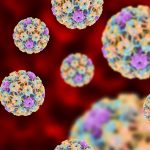WNF: Naturopathic Education Globally
Naturopathic News
Iva Lloyd, ND, RPP
 The most common question asked of naturopathic doctors – and the most common misconception about the global naturopathic profession – is about naturopathic educational standards. Most naturopathic doctors in North America assume that they have the best education, hands-down. Don’t get me wrong – the naturopathic education offered in North America is great – but there are other naturopathic programs around the world that are also top-notch.
The most common question asked of naturopathic doctors – and the most common misconception about the global naturopathic profession – is about naturopathic educational standards. Most naturopathic doctors in North America assume that they have the best education, hands-down. Don’t get me wrong – the naturopathic education offered in North America is great – but there are other naturopathic programs around the world that are also top-notch.
If we just count the naturopathic educational institutions that meet the World Health Organization’s (WHO) Benchmarks for Naturopathy, we are looking at over 100 schools globally. The breakdown of schools is roughly as follows: 45 in Europe, 22 in South East Asia (mostly India), and then 10 in each of Latin America, North America, and Western Pacific regions. There are currently 2 schools in Africa and none in the Eastern Mediterranean.1
As expected, there is a strong correlation between the regulatory status of the naturopathic profession in a region and the educational standards that are offered. The World Naturopathic Federation (WNF) is supporting an ongoing research project examining the correlation between education and regulation.
2016 Global Survey of Naturopathic Educational Institutions
In February 2016, the WNF conducted a global survey of naturopathic educational institutions. The survey was a follow-up to the one conducted in 2015 that focused on naturopathic professional organizations. The survey was sent to 85 naturopathic institutions, from 49 different countries, that had a minimum standard of 1500 teaching hours, as set by the WHO. The WNF received 30 complete responses from 17 countries.2
The highlights of the survey were as follows:
- 50% of the naturopathic institutions that responded were opened between 1975 and 2000
- The European schools tend to have fewer students, whereas the schools in North America, Western Pacific, and Asia have the most
- 61% of the schools offer programs of 3000 hours or longer. The longer programs (>4000 hours) are primarily from North America, Western Pacific, and Asia.
- The trend for newly established schools outside of Europe is to start naturopathic programs that are at least 3000 hours in length. There was a positive correlation between the length of the program and the number of students.
- 70% indicated that the naturopathic history, principles, philosophies, and theories constitute a separate module in the curriculum
- 100% of the schools teach basic sciences; clinical sciences; naturopathic history, principles, philosophy and theories; and naturopathic disciplines (nutrition, herbal medicine, hydrotherapy, physical therapy, homeopathy, lifestyle counselling, etc)
- There is high agreement on the 6 naturopathic principles taught at the naturopathic institutions
- The following 10 naturopathic philosophies and theories are taught in over 70% of all naturopathic institutions: Vital Force, Integration of the Individual, Naturopathic Cures, Value of Fever, Therapeutic Order, Triad of Health, Unity of Disease, Hering’s Law of Cure, Theory of Toxemia, and Humoral Theory. The first 3 listed are taught in 96% of all schools.
- All 30 respondents itemized the diagnostic methods taught in the naturopathic program. As expected, diagnostic methods essential to primary care and adequate diagnostic skills (ie, clinical assessment and diagnostic exams) are included in 88% and 86%, respectively, of all programs. Government regulations limited some core diagnostic methods, such as physical exams and laboratory testing. High consistency was shown for clinical assessment, physical exams, laboratory testing, biotypology and somatotypes, and traditional humoral diagnosis.
- Although the naturopathic profession is known for offering an eclectic array of treatment modalities, the following 7 naturopathic modalities are core to most naturopathic programs: Clinical Nutrition, Applied Nutrition, Botanical Medicine, Hydrotherapy, Homeopathy, Physical Therapies, and Lifestyle Counseling.
- The diversity in naturopathic treatments seen by region reflects both the ability of naturopathy to easily support the traditional medicines from a country and the length of training that is offered. For example, minor surgery is generally only included in the longer programs, such as those offered in North America. And the inclusion of Ayurvedic therapies is seen in countries that already utilize Ayurvedic treatments.
Establishment of Naturopathic Institution
Based on the details from the “2015 World Naturopathic Federation Report”3 and books on the history of naturopathy, we believe that the first official naturopathic school was opened in 1901 by Benedict Lust, student of Father Kneipp, in New York. Some of the naturopathic schools that opened in the early 1900s are still in operation today. In the early 1920s, formal naturopathic schools, such as the one established in 1925 by José Castro Blanco in Spain, started opening in Europe. Other naturopathic schools opened around that time including one in Munich, Germany, by Josef Angerer Schule, which still exists today. One of the students of Benedict Lust’s NY naturopathic school was the French-Argentine ND Professor, Juan Estève Dulin. He was instrumental in bringing naturopathy to South America, France, and Spain. In 1919 Dulin established The “Argentine Naturist Association,” which in 1934 changed to “Asociación Naturista de Buenos Aires.” Due to the efforts of Prof Dulin, naturopathic schools have been established in Argentina, Uruguay, Brazil, France, and Spain – for example, the “Universidad Popular Naturista,” the “Escuela Argentina de Naturopatía,” and “Escuela Naturista Prof. Juan Estève Dulin.”
Prior to 1950, most naturopathic schools were located in Europe. In North America, a number of naturopathic schools were established between 1901 and the 1930s; however, most of them were closed between the 1930s and 1950s for various reasons. Since the 1970s there has been a resurgence of the naturopathic profession worldwide and it continues to grow and expand into every region of the world. (See Figures 1 & 2)
Figure 1. Percentage of Schools Established, by Year (Q6); n=30
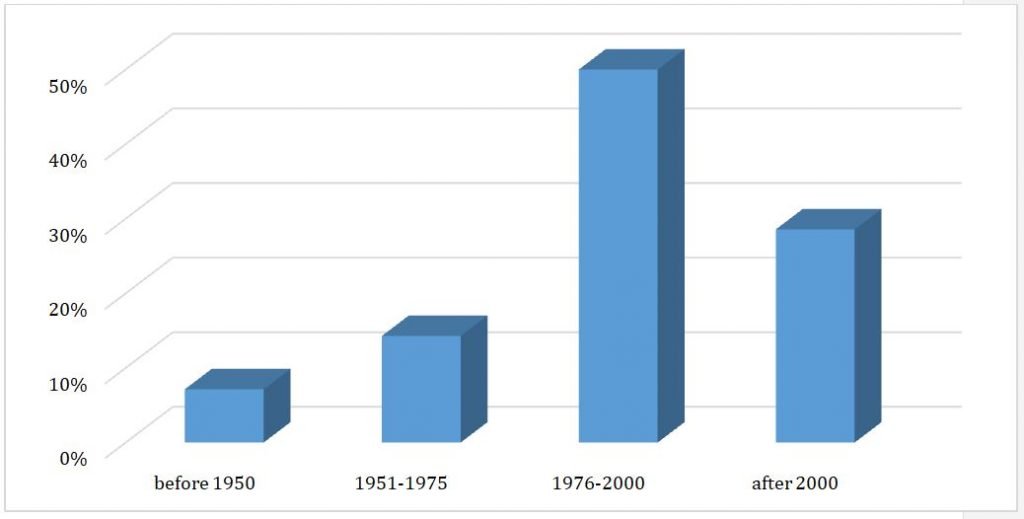
Figure 2. Year Naturopathic Institution was Established, by World Region
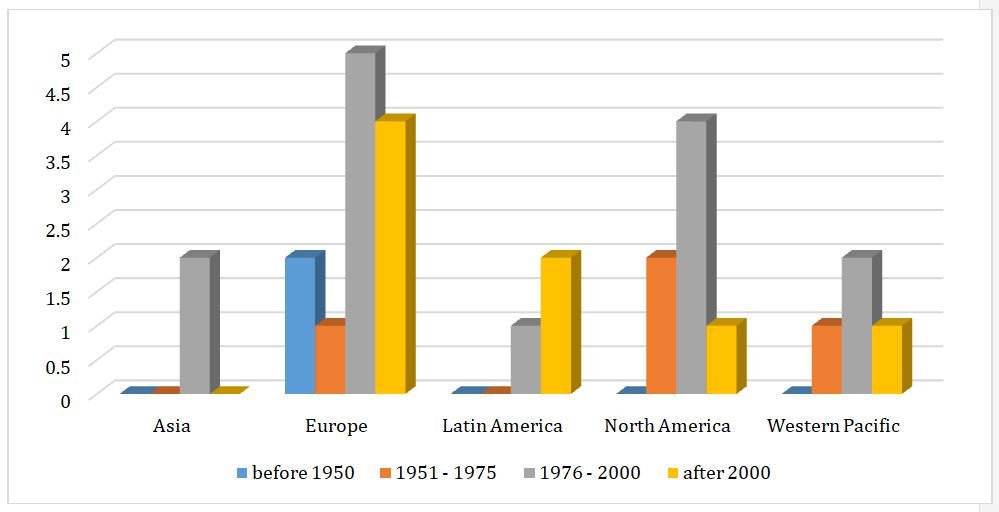
As shown in Figure 2, a number of naturopathic schools have opened since 1951 in Europe, North America, and Western Pacific, and each of these regions continues to see a growth in the number of naturopathic programs. Asia indicates growth in naturopathic programs in the period 1976-2000. Most of the growth in naturopathic programs in Latin America has been within the last 20 years.
Length of Naturopathic Program
To be an educational member of the WNF, a naturopathic school must meet the 1500-hour minimum education standards for a naturopathic program, as set by the WHO. Only 2 respondents indicated that their program was less than 1500 hours, though greater than 1200 hours.
One of the challenges of the naturopathic profession worldwide is the variability in the length of the naturopathic programs (Table 1). However, there is a trend for naturopathic programs to be closer to a minimum of 3000 hours. This increasing trend is expected to continue especially in new programs established in Europe.
Table 1. Length of Naturopathic Program (Q8); n=28
| Answers (in Hours) | Responses (%) |
| Less than 1500 hours | 7.4% |
| 1501-1999 hours | 18.5% |
| 2000-2999 hours | 14.8% |
| 3000-3999 hours | 33.3% |
| Over 4000 hours | 25.9% |
When looking at the length of the program based on region, we see that most of the variability is within Europe and Latin America. Figure 3 shows that the naturopathic programs in Asia are between 2000 and 3999 hours. Six of the 7 schools in North America offer a program that is over 4000 hours, and all programs in the Western Pacific are over 3000 hours. Since the survey was published, the WNF has become aware of naturopathic programs in India that are also over 4000 hours.
Figure 3. Length of Naturopathic Program, by World Region
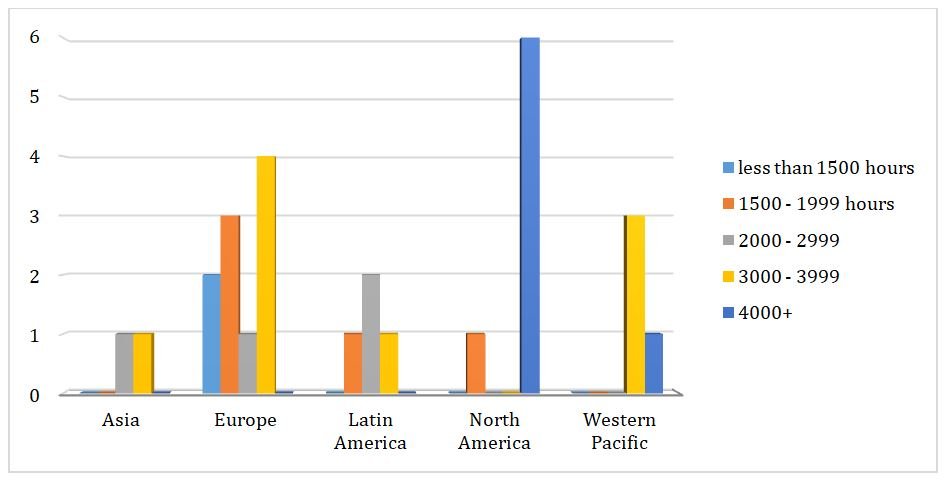
Type of Naturopathic Program
76% of the naturopathic institutions offer a full-time program. As shown in Table 2, a number of naturopathic institutions offer a part-time option as part of a full-time program.
Table 2. Type of Naturopathic Program (Q9); n=29
| Answers | Responses |
| Full-time program | 76% |
| Part-time program | 52% |
| Online program | 14% |
| In Detail | |
| Full-time only | 12 schools / 41% |
| Full-time and part-time program | 6 schools / 21% |
| Full-time, part-time and online program | 2 schools / 7% |
| Full-time, online program | 2 schools / 7% |
| Part-time only | 7 schools / 24% |
Figure 4 highlights the fact that part-time programs are only offered in Europe and Latin America. All world regions offer some degree of mixed programs – generally full-time programs with the option of taking part of the program part-time as well. The majority of North American programs are only full-time. The WNF recommends that naturopathic programs be primarily in-class instruction.
Figure 4. Type of Naturopathic Program, by World Region
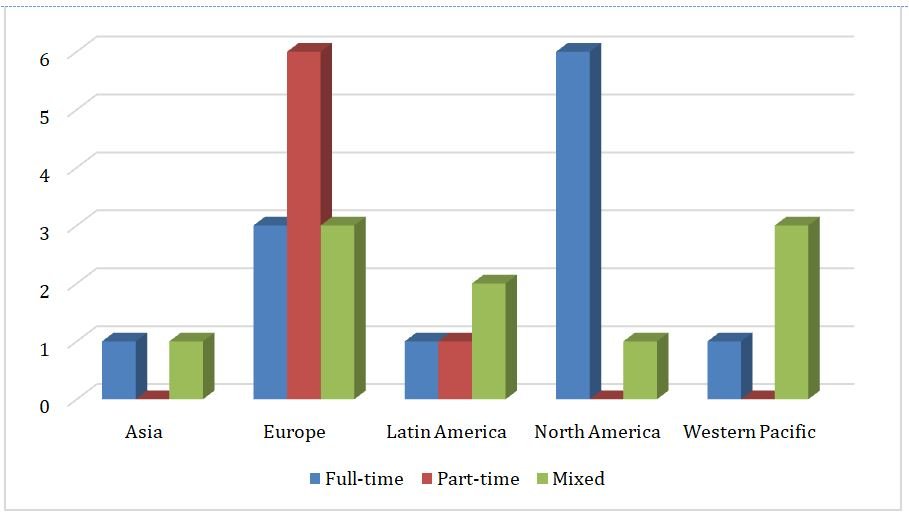
Curriculum Content
Of respondents, 100% indicated that their naturopathic program contained the following 5 elements: basic sciences; clinical sciences; naturopathic history, principles and philosophy; naturopathic disciplines; and a practical clinical component.
When analyzing the percentage of time spent in each aspect of the naturopathic program, it was found that an average of 31% of the curriculum involves teaching naturopathic disciplines and that 24.1% of the curriculum includes the practical clinical component.
Table 3 provides a glimpse of the average number of hours spent in each aspect of the naturopathic program, based on length of the overall program. The longer programs significantly increase the time spent on the basic sciences, clinical sciences, and the practical clinical component.
Overall, the time spent on naturopathic history, philosophy, and theories does not vary significantly based on the length of the program.
Table 3. Hours Spent in Each Aspect of Curriculum, by Length of Program
| Length of Program (Hours, average) | Basic Sciences | Clinical Sciences | Naturopathic History | Naturopathic Disciplines | Practical Clinical |
| <1500 h | 275 | 258 | 115 | 410 | 200 |
| 1500-1999 h | 303 | 263 | 317 | 596 | 476 |
| 2000-2999 h | 250 | 325 | 175 | 1100 | 300 |
| 3000-3999 h | 594 | 720 | 287 | 1200 | 748 |
| 4000+ h | 1099 | 765 | 190 | 1129 | 1340 |
Naturopathic Principles
Similar to the results published in the “2015 World Naturopathic Federation Report,”3 the respondents indicated an extremely high degree of consistency in the naturopathic principles: First, Do No Harm (Primum non nocere) (93%); Healing Power of Nature (Vis medicatrix naturae) (97%); Treat the Cause (Tolle causam) (93%); Treat the Whole Person (Tolle totum) (100%); Naturopathic Practitioners as Teachers (Docere) (86%); and Disease Prevention and Health Promotion (100%).
Naturopathic Philosophies & Theories
The philosophies and theories of a system of medicine influence every aspect of assessment, diagnosis, and treatment. They dictate what information is sought and how it is interpreted. They determine whether the emphasis of the patient-practitioner relationship is on addressing the factors that cause disease or on treating the symptoms and pathology. They determine whether health and disease are viewed as logical or random, and whether a practitioner is trained to integrate all aspects of a patient or to address specific pathological conditions.
All respondents indicated a strong agreement with many of the naturopathic philosophies and theories taught in the naturopathic curriculum. As shown in Figure 5, the common theories and philosophies include: Vital Force (Vis vitalis) / Theory of Vitality, Integration of the Individual – spiritual, psychological, functional, structural (Mind, Body, Spirit), and Naturopathic Cures – detoxification, revitalization, stabilization, and regeneration (taught in 96% of the programs); Value of Fever (89%); Therapeutic Order (85%); Naturopathic Triad of Health and Unity of Disease (81%); Hering’s Law of Cure and Theory of Toxemia (78%); Humoral Theory (74%); and Theory of Complex Systems and Emunctories / Emunctory Theory (67%).
Figure 5. Naturopathic Philosophies & Theories Taught (Q20); n=30
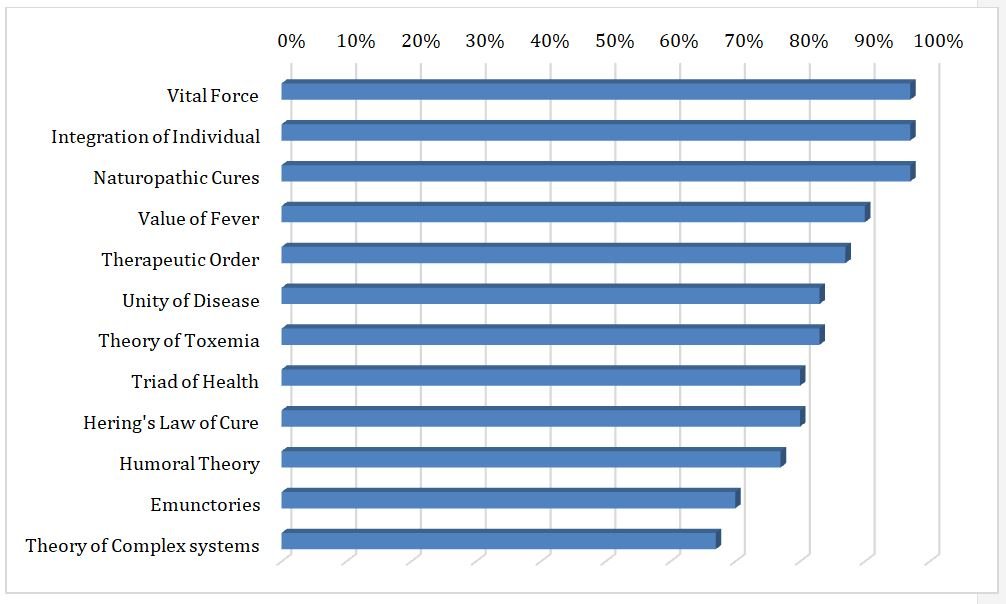
Naturopathic Diagnostic Methods
All respondents indicated the diagnostic methods that were taught in their naturopathic program (see Figure 6). As expected, those diagnostic methods essential to primary care and adequate diagnostic skills (ie, clinical assessments and physical exams) were included in 88% and 86%, respectively, of all programs. Some core diagnostic methods, such as physical exams and laboratory testing, were reported to be limited in some regions due to government regulations. High consistency was shown in clinical assessment, ie, standard medical assessment including auscultation, palpation, percussion, observation (tongue, skin, nails, eyes), neurological exam, cardiovascular exam, etc (92%); physical exams (85%); laboratory testing (blood, urine, hair, sweat, saliva, stool, etc) (80%); iridology (72%); biotypology and somatotypes (62%); traditional humoral diagnosis (including urine and pulse) (59%); and traditional Chinese diagnosis (including tongue and pulse) (57%).
Figure 6. Diagnostic Methods Included in Naturopathic Programs (Q24); n=30
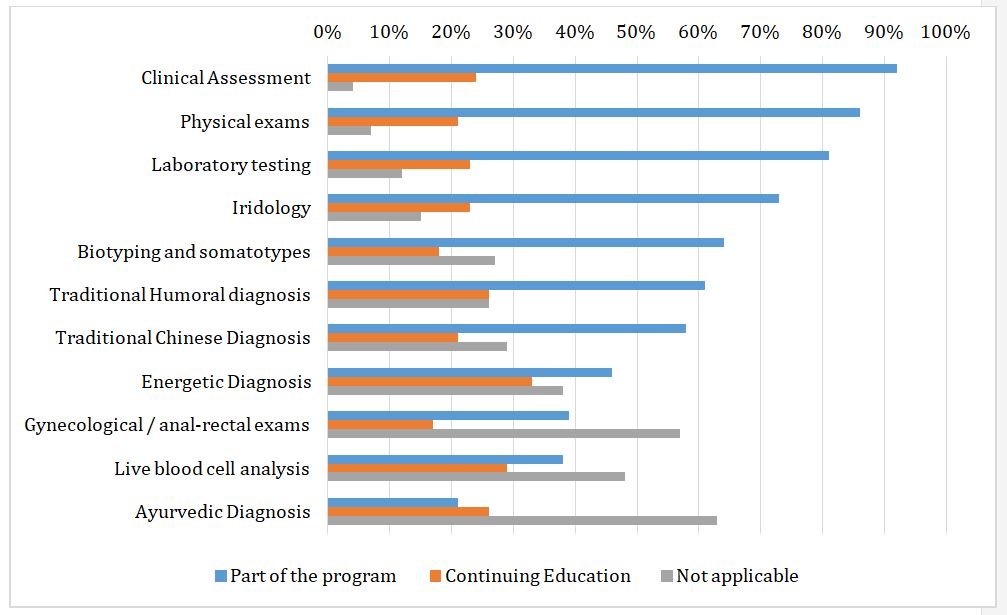
Other diagnostic methods that were included in some naturopathic programs included energetic diagnosis (eg, therapies such as bio-electronic, Vega, Mora, kinesiology muscle testing, radionics, and radiesthesia) (46%); gynecological/anorectal exams (39%); live blood cell analysis (38%); and Ayurvedic diagnosis (21%).
The survey also analyzed the diagnostic methods based on length of program. It was found that the more medical diagnostic methods – such as physical exams, clinical assessment, and laboratory testing – are generally associated with longer naturopathic programs. Other diagnostic methods – such as iridology, energetic assessment, and biotypology – are more likely to be associated with shorter naturopathic programs. Specific diagnostic methods, such as gynecological exams, live blood cell analysis, or traditional humoral theory, are more likely to be associated with specific regions than with program length.
Figure 7. Diagnostic Methods, by World Region
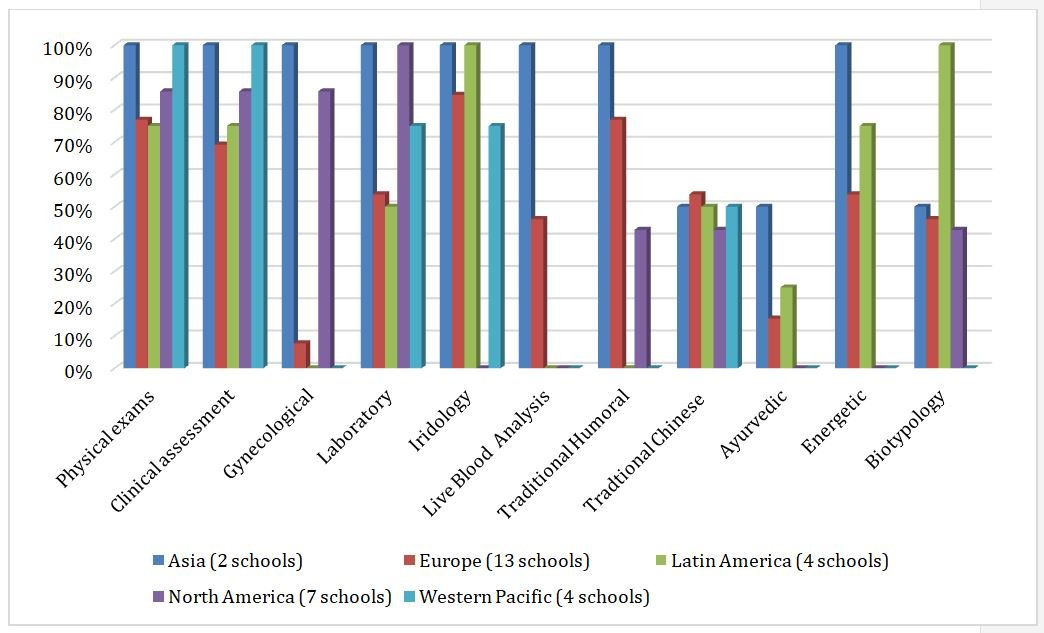
Naturopathic Modalities
In the “2015 World Naturopathic Report,”3 the following 11 modalities or treatments were reported as having a high degree of consistency and being part of the practice of naturopathy / naturopathic medicine in each country: hydrotherapy (93%); massage techniques (88%); botanical medicine (87%); physical medicine practices (85%); energetic therapies (85%); lifestyle counseling (80%); clinical nutrition (80%); TCM practices (79%); right to direct access to patients (77%); homeopathy (77%); and colonics (75%). The respondents in the 2015 World Naturopathic Report included naturopathic schools and naturopathic organizations (primarily national).
All respondents reported on the naturopathic modalities taught in their naturopathic program. As shown in Figure 8, there is a high degree of consistency among naturopathic modalities. The following is the list of the most common modalities and the percentage that they are taught in naturopathic programs: clinical nutrition (100%); applied nutrition (97%); botanical medicine (93%); hydrotherapy (83%); massage and soft tissue techniques (79%); physical manipulation (72%); counseling and naturopathic psychotherapy (72%); homeopathy (66%); pharmacology (66%); and energetic therapies (48%).
Figure 8. Naturopathic Modalities Taught (Q25); n=30
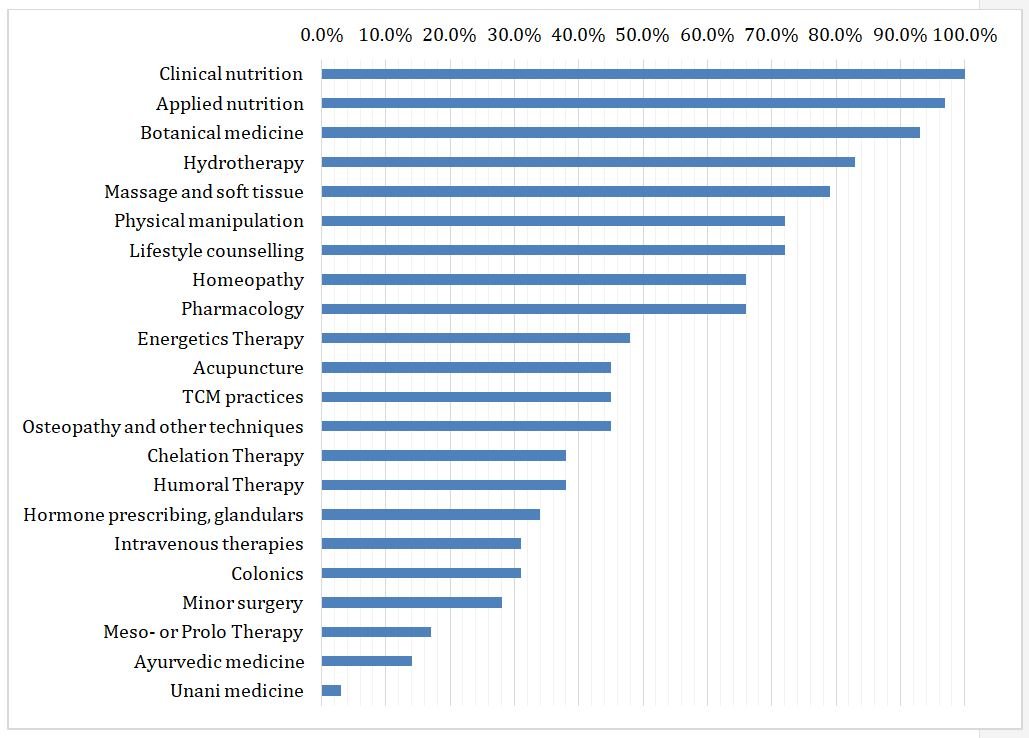
Other modalities that are taught include: acupuncture (45%); TCM practices (45%); osteopathy and other manipulative techniques (45%); chelation therapy (38%); hormone prescribing (34%); humoral therapy (cupping, Baunscheidt, etc) (38%); intravenous therapies (31%); colonics (31%); minor surgery (28%); meso- or prolotherapy / neural therapy (17%); and Ayurvedic medicine (14%).
Further analysis revealed that hydrotherapy – which is typically considered part of the naturopathic system of medicine – was only taught in 1 of the 4 schools that responded from the Western Pacific; 2 schools in Europe omitted hydrotherapy and botanical medicine as modalities; homeopathy was also omitted from schools in Asia, 5 of the schools in Europe, and 2 of the schools in the Western Pacific. Humoral therapy – a central therapy for traditional naturopathy – is primarily taught as a naturopathic modality in schools in Europe. Seventy-four percent of the respondents considered humoral therapy more as a theory than a treatment modality.
Hormone prescribing, intravenous therapies, meso- or prolotherapy, and minor surgery were taught in schools in North America, 2 schools in Europe, and 1 in Asia. The schools that taught one of these modalities were likely to teach all of them. These results correlate with what we know of the scope of practice in these regions, and correlate with naturopathic programs with a higher number of program hours, especially in North America.
Overview of Naturopathic Education by World Region
The following is an overview by world region:
- Africa: The WNF is aware of 2 naturopathic institutions in Africa: the University of Western Cape in South Africa, which is a 4200-hour program that opened in 2002, and the Zambia Institute of Natural Medicine and Research, which was started by the WHO and AFRO, based on the 4200-hour curriculum of the Canadian College of Naturopathic Medicine in Canada.
- Asia: There are over 20 educational institutions in India. Many of the programs in India are 4 ½ years in length. Nepal offers a naturopathic educational program that is 3 ½ years long. In Asia, yoga is an integral part of the naturopathic programs.
- Europe: Europe is home to the oldest and greatest number of naturopathic educational institutions and the greatest variability in educational standards. That being said, there are programs in Europe that are over 3000 and 4000 hours in length and that are comparable in content to programs in North America.
- Latin America: The majority of naturopathic schools offer programs over 2000 hours and offer enrollment to 100-250 students. The school in Puerto Rico, Universidad del Turabo, currently has candidacy status with Council on Naturopathic Medical Education (CNME).
- North America: North America has the highest accreditation standard for naturopathic education. Seven of the programs are accredited by CNME, and all offer program in excess of 4000 hours. The remaining 4 naturopathic schools exist in Quebec, Canada. Three of the 4 Quebec schools offer a naturopathic program that is at least 2000 hours in length; one of the schools – L’École d’Enseignement Supérieur de Naturopathie (EESNQ) – offers a program that is over 4000 hours and is currently working towards CNME accreditation.
- Western Pacific: The oldest school in Australia, the Southern School of Natural Therapies, in Melbourne, was established in 1961 and has offered a 4-year degree course for over 15 years. The majority of naturopathic educational institutions offer programs over 3000 hours, and all but one of the schools offer enrollment to about 100-249 students at a time. One school, Endeavor College of Natural Health, in Australia, has a total enrollment of over 400 students at a time.
Global Challenges Facing Naturopathic Educational Institutions
There is a lot of strength and wisdom in the naturopathic educational institutions globally, but there are also challenges. The following are some of the challenges and the steps being taking to overcome them:
- Latin America: The main challenge is the lack of naturopathic educational resources (books, journals, databases, etc) in Spanish. The WNF is working on strategies with many of the Latin American countries on fundraising in order to translate key resources.
- Europe: Many of the European naturopathic organizations have been working over the last few years to increase the minimal standards of education in that region and to have the European Union recognize naturopathy.
- Research: The need for naturopathic research has been identified as a key strategy for the WNF and many other established naturopathic organizations and educational institutions. The International Research Consortium of Naturopathic Academic Clinics was formed in 2017 by Endeavor College of Natural Health, Bastyr University, and the Canadian College of Naturopathic Medicine, with the aim of advancing naturopathic research internationally.
- Continuing Education: Many naturopathic organizations from around the world have requested broader access to continuing education. The WNF intends to work with our members to help facilitate this process.
Summary
The consistency found in the 2015 and 2016 WNF surveys allowed us to create the document “Defining the Global Naturopathic Profession,”4 and the 2016 survey provided the foundation for the “WNF White Paper on Naturopathic History, Philosophy, Principles and Theories.”5
Although the goal of the WNF is not to standardize naturopathic education globally, its aim is to assist in the strengthening of all naturopathic educational programs and to provide a forum for naturopathic educational institutions to share resources and to collaborate.
One goal of the WNF is to collaborate with the WHO and update the Benchmarks on Naturopathy. By doing so, we expect that the minimal educational standards will increase to at least 2500 hours.
If you would like more information on naturopathic education globally, we encourage you to read the 2016 Naturopathic Roots Report at http://worldnaturopathicfederation.org/wnf-publications/.2
References:
- 2016 Naturopathic Numbers Report. June 2016. WNF Web site. http://worldnaturopathicfederation.org/wp-content/uploads/2015/12/2016-Naturopathic-Numbers-Report.pdf. Accessed March 11, 2018.
- WNF – Naturopathic Roots Report. Findings from the Naturopathic Roots Committee Survey. June 2016. WNF Web site. http://worldnaturopathicfederation.org/wp-content/uploads/2015/12/Naturopathic-Roots_final.pdf. Accessed March 12, 2018.
- World Naturopathic Federation Report. Findings from the 1st World Naturopathic Federation survey. June 2015. WNF Web site. http://worldnaturopathicfederation.org/wp-content/uploads/2015/12/World-Federation-Report_June2015.pdf. Accessed March 11, 2018.
- World Naturopathic Federation. Defining the Global Naturopathic Profession. July 2017. WNF Web site. http://worldnaturopathicfederation.org/wp-content/uploads/2016/03/Defining-the-Global-Naturopathic-Profession_WNF-2017_.pdf. Accessed March 12, 2018.
- WNF White Paper: Naturopathic Philosophies, Principles and Theories. July 2017. WNF Web site. http://worldnaturopathicfederation.org/wp-content/uploads/2015/12/WNF_White_Paper_June-2017.pdf. Accessed March 12, 2018.


